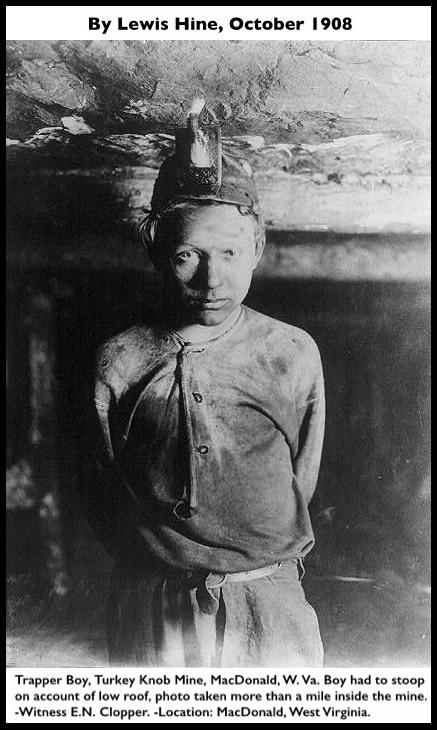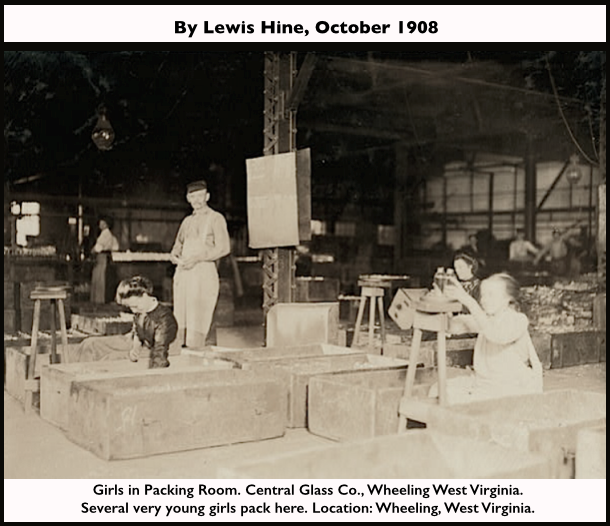 ~~~~~~~~~~~~~~~~~~~~~~~~~~~~~~~~~~~~~~~~~~~~~
~~~~~~~~~~~~~~~~~~~~~~~~~~~~~~~~~~~~~~~~~~~~~
Hellraisers Journal – Monday November 23, 1908
Report on Recent Legislation from the National Child Labor Committee
From the Duluth Labor World of November 21, 1908:
EFFORTS TO SUPPRESS CHILD LABOR EVILS
—–
Nine States Have Passed Remedial Measures
and Entire Country is Aroused.
—–
But Much Yet Remains to be Done
to Protect American Children.
—–Mr. A. J. McKelway, secretary of the National Child Labor Committee for the southern states has recently published a report of the years’ progress in child labor legislation, from which we glean the following excerpts.
Progress in 1908.
The year 1908 was an off year in state legislative sessions, as thirty-eight states have their legislatures meet in 1909. The national child labor committee reports progress in nine states, in addition to the passage of the District of Columbia child labor bill, which had been agitated for several years. This act of federal legislation was not all that was hoped for by the friends of the cause, as the pages of the senate, though not of the house, and the children of dependent parents are exempted from the operation of the law. In other respects the law approaches the standard of the more advanced states.
New York State.
An important amendment to the New York child labor law was the transferring of the enforcement of the mercantile child labor provisions from the local boards of health to the state labor department, and the provision for a bureau of mercantile inspection. This amendment was bitterly contested by interested parties and Governor Hughes sent two special messages to the legislature concerning the necessity of this change in the law.
New Jersey and Ohio.
In New Jersey, the effort to forbid night work for children under 16 years of age failed, but a compulsory education amendment requires children from 7 to 17 to attend school, except that children of 15 who are regularly employed are excused from such attendance.
In Ohio two efforts to weaken the child labor law failed and an eight-hour law was passed for boys at work under 16 and for girls under 18. This puts Ohio abreast of the most advanced states in this regard.
West Virginia and Kentucky.
In West Virginia a compulsory education law was passed, providing for school attendance for children under 15 years of age, for six months of the year.
In Kentucky the minimum age of 14 years without any exemptions was fixed by law by raising the age limit for employment in factories from 12 to 14. One provision of the Virginia law in addition promises a more rigid enforcement then is usual, namely, the making it prima facie evidence of guilt, on the part of both parents and employer to hire a child under the legal age.
In Mississippi.
Mississippi passed a child labor law for the first time this year. Investigations conducted under the auspices of the national child labor committee proved that 25 per cent of the operatives of the cotton mills were under the age of 14 and that 50 per cent of the child workers were illiterate. The publication of these facts had an immediate effect upon public sentiment, though the opposition of the manufacturers forced the minimum age limit from 14 down to 12, with a 60-hour week allowed by law.
In Louisiana.
Louisiana, has for many years had a child labor law with an age limit of 14 for girls and 12 for boys. At the recent session of the legislature, under the advocacy of Miss Jean Gordon of New Orleans, the most advanced child labor law of any southern state was enacted. There was a majority of one vote in the house and one in the senate for the new law, but it was passed and approved. The age limit is raised to 14 for both sexes, and effective provisions are made, for the issuing of employment certificates, for proper safety appliances and sanitary measures, and effective factory inspection.
General Review.
During the four years of the existence of the national child labor committee, it has contributed more or less directly to successful campaigns in thirty-five states, most of these states amending their child labor laws in the right direction, but several of them passing such legislation for the first time. There remain now but the two states of Oklahoma and Nevada without a child labor law. Only seven states remain with the 12-year age limit, Maryland, West Virginia, South Carolina, Florida, Georgia, Mississippi and Texas, the latter state having an age limit of 16 for mines. North Carolina has an age limit of 13. The standard age limit for this country and Europe is 14 years. This should be raised to at least 16 for night work, and by way of putting a premium on education to 16 for illiterate children.
Two of the states, Georgia and South Carolina, allow children under 12 years of age to work in factories, if the children of dependent parents. Georgia fixing the age of such children at 10 years and South Carolina making no limit at all. Two states, Georgia and North Carolina, still allow the 66-hour week in factories, which, with the custom of giving a half-holiday on Saturdays, means a 12-hour day for the first five working days at the week.
In a great many of the states defective laws allow the employment of thousands of children who are really under the legal age. In all the cotton manufacturing states, the longer hours prevail for children, Massachusetts, with a 58-hour week and Pennsylvania with its 60-hour weeK, to Georgia and North Carolina with the 60-hour week. In most of the newer industrial states, proper factory inspection is the crying need, as the child labor laws are ineffective and poorly enforced without this system. Much therefore remains to be done in the United States for the effective protection of the children who toil, from the inevitable consequences to the body, the mind and the spirit, of too early an too long continued labor.
———-
[Paragraph breaks and photographs by Lewis Hine added.]
Report from New York City:
CHILD WORKERS.
According to the records compiled by the health department of New York city more than twice as many children are seeking employment this fall as sought it last fall, and there has been a decided falling off in marriages.
In September last year 1,300 children, 14 years old, applied for certificates that they might become bread-winners. Last month more than 2,700 children asked for employment certificates.
There is only one construction put upon this unprecedented increase by the health board. That is, that a larger number of parents find themselves at the approach of winter without employment, or with their earning capacity reduced so that the children’s help must be enlisted.
The apparent falling off in marriages is almost as noticeable as is the increase in the number of children asking to be allowed to go to work, though the figures at the department may be misleading, for some clergymen who performed marriage ceremonies may not have returned the certificates, as required by law.
———-
~~~~~~~~~~~~~~~~~~~~~~
SOURCES
Quote Mother Jones, Alabama Child Labor, AtR p2, Oct 24, 1908
https://www.newspapers.com/image/67587501
The Labor World
(Duluth, Minnesota)
-Nov 21, 1908
https://chroniclingamerica.loc.gov/lccn/sn78000395/1908-11-21/ed-1/seq-2/
https://chroniclingamerica.loc.gov/lccn/sn78000395/1908-11-21/ed-1/seq-4/
IMAGES
Child Labor, Trapper Boy MacDonald WV by Hine, Oct 1908, LoC
http://www.loc.gov/pictures/item/2018673782/
Child Labor, Girls in Packing Room, Wheeling WV by Hine, Oct 1908, LoC
http://www.loc.gov/pictures/item/2018673808/
See also:
Charities and the Commons
Oct 1908-March 1909
(New York, New York)
https://books.google.com/books?id=HjRHAQAAIAAJ
Edition of Jan 30, 1909
https://play.google.com/books/reader?id=HjRHAQAAIAAJ&printsec=frontcover&pg=GBS.PA733
“Child Labor in the Carolinas”
-by A. J. McKelway, Secretary for the Southern States
–with photos by Lewis Hine
https://play.google.com/books/reader?id=HjRHAQAAIAAJ&printsec=frontcover&pg=GBS.PA743
http://sites.dlib.nyu.edu/undercover/sites/dlib.nyu.edu.undercover/files/documents/uploads/editors/Child-Labor-in-the-Carolinas.pdf
National Child Labor Committee
https://en.wikipedia.org/wiki/National_Child_Labor_Committee
LoC, Photographs, Hine, October 1908
http://www.loc.gov/pictures/search/?q=hine+1908+october&sp=1
End Slavery Now-Child Labor
http://www.endslaverynow.org/learn/slavery-today/child-labor
~~~~~~~~~~~~~~~~~~~~~~~~~~~~~~~~~~~~~~~~~~~~~
Child Labor and Lewis Hine-Pt. 1
Babies in the Mill – Dorsey Dixon


